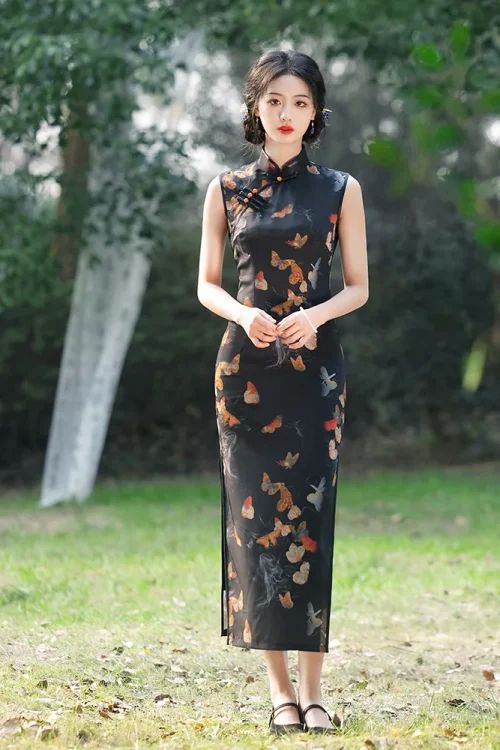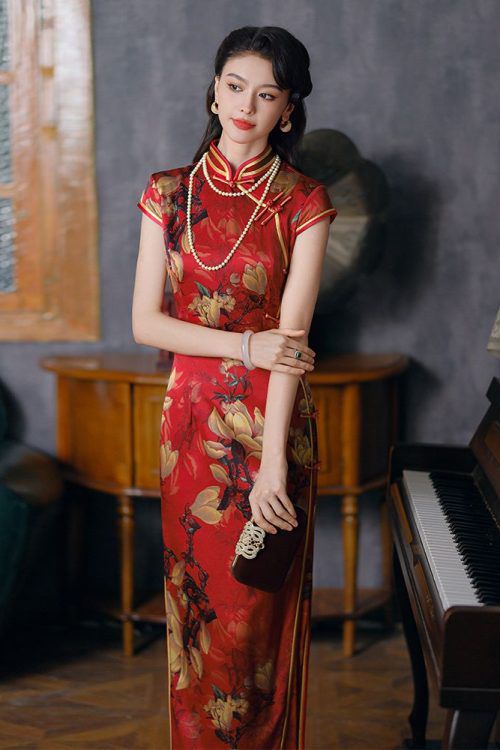O Qipao as a Symbol of Cultural Identity
The qipao, a traditional Chinese dress, has emerged as a potent symbol of cultural identity in contemporary Chinese cinema. Its elegant silhouette and intricate designs evoke a sense of nostalgia and connection to the nation’s rich heritage.

Cinematic Representation
In films like Lust, Caution e The Flowers of War, the qipao serves as a visual representation of the complexities of Chinese identity during tumultuous historical periods. The characters’ choices to wear or discard the garment reflect their struggles with tradition, modernity, and the search for self-expression.
Female Empowerment
Moreover, the qipao has become a symbol of female empowerment in Chinese cinema. In Crouching Tiger, Hidden Dragon, the qipao-clad heroine, Yu Shu Lien, embodies both strength and grace. Her ability to fight and defend herself while wearing the traditional dress challenges societal norms and empowers female characters.
Cultural Fusion
The qipao’s versatility extends beyond its historical and cultural significance. In contemporary films like Crazy Rich Asians e The Farewell, it has been reimagined as a symbol of cultural fusion and the evolving nature of Chinese identity. By incorporating modern elements into the design, these films explore the intersection of tradition and modernity in the Chinese diaspora.
Fashion Statement
Furthermore, the qipao has become a fashion statement in its own right. Its timeless elegance and adaptability have made it a popular choice for red carpet events and fashion editorials. Designers like Guo Pei and Vivienne Westwood have created stunning qipao-inspired gowns that showcase the garment’s enduring appeal.
Conclusão
In conclusion, the qipao has evolved into a multifaceted symbol in contemporary Chinese cinema. It represents cultural identity, female empowerment, and the fusion of tradition and modernity. Its enduring presence on the silver screen reflects the complex and ever-changing nature of Chinese society and its search for self-expression in a globalized world.
The Qipao as a Fashion Statement
The qipao, an iconic Chinese dress, has transcended its traditional role to become a powerful symbol in contemporary Chinese cinema. Its elegant silhouette and intricate designs have captivated audiences, evoking a sense of nostalgia, cultural identity, and female empowerment.

Modernity and Liberation
In the early 20th century, the qipao emerged as a symbol of modernity and liberation for Chinese women. Its form-fitting design challenged traditional gender norms, allowing women to express their individuality and embrace a more active role in society. This transformative power is reflected in films such as Lust, Caution (2007), where the qipao becomes a tool for espionage and seduction, empowering the female protagonist to navigate a dangerous world.
Cultural Heritage
Moreover, the qipao has become a symbol of cultural heritage and national pride. In films like The Grandmaster (2013), the qipao is depicted as a garment that embodies the traditions and values of Chinese society. Its intricate embroidery and vibrant colors evoke a sense of cultural continuity, connecting the past to the present.
Themes of Empowerment
Furthermore, the qipao has been used to explore themes of female identity and empowerment. In The Flowers of War (2011), the qipao becomes a symbol of resilience and strength for the women who are forced to confront the horrors of war. By wearing the qipao, they assert their dignity and refuse to be defined by their circumstances.
Evolving Fashion
In contemporary Chinese cinema, the qipao continues to evolve as a fashion statement. Designers have reinterpreted the traditional design, incorporating modern elements and experimenting with new fabrics and silhouettes. This evolution reflects the changing role of women in Chinese society, as they embrace both tradition and modernity.
Enduring Presence
The qipao’s enduring presence in Chinese cinema is a testament to its versatility and cultural significance. It has become a symbol of female empowerment, cultural heritage, and national pride. As Chinese cinema continues to evolve, the qipao will undoubtedly remain a powerful and evocative fashion statement, shaping the narratives and identities of Chinese women on screen.
The Qipao as a Vehicle for Social Commentary
The qipao, a traditional Chinese dress, has emerged as a potent symbol in contemporary Chinese cinema, transcending its role as mere attire to become a vehicle for social commentary. Its form-fitting silhouette and vibrant colors have captivated audiences, while its historical and cultural significance has imbued it with a profound resonance.

Importância histórica
In films like Lust, Caution e The Flowers of War, the qipao serves as a poignant reminder of China’s tumultuous past. Its association with the glamorous Shanghai of the 1930s evokes a sense of nostalgia and longing, while its presence in wartime settings underscores the resilience and suffering of the Chinese people.
Gender Roles
Moreover, the qipao has become a powerful tool for exploring gender roles and female empowerment. In Raise the Red Lantern, the qipao’s vibrant hues and intricate embroidery symbolize the beauty and allure of the concubines, yet also highlight their confinement and oppression. Conversely, in Crouching Tiger, Hidden Dragon, the qipao empowers the female characters, allowing them to move with grace and agility as they navigate a male-dominated world.
Versatile Symbolism
The qipao’s versatility extends beyond its historical and gendered connotations. In In the Mood for Love, it becomes a symbol of longing and unrequited love, its flowing fabric and muted colors mirroring the characters’ unspoken emotions. In The Grandmaster, it represents the martial arts tradition, its sleek lines and intricate patterns evoking the discipline and grace of kung fu.
Cultural Identity
Furthermore, the qipao has become a symbol of cultural identity and national pride. In Farewell My Concubine, it serves as a reminder of China’s rich theatrical heritage, while in The Last Emperor, it evokes the grandeur and opulence of the Qing dynasty. By showcasing the qipao in its various forms, Chinese cinema celebrates the country’s cultural diversity and historical legacy.
Conclusão
In conclusion, the qipao has evolved into a multifaceted symbol in contemporary Chinese cinema. Its historical, cultural, and gendered associations have made it a powerful tool for social commentary, allowing filmmakers to explore themes of nostalgia, oppression, empowerment, and national identity. Through its vibrant colors, flowing fabric, and intricate designs, the qipao continues to captivate audiences and serve as a testament to the enduring power of Chinese culture.
